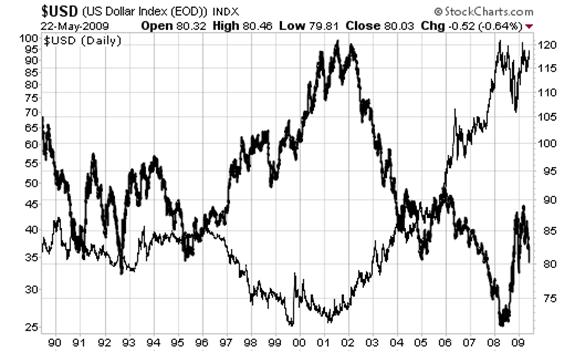U.S. Dollar, the Worst Investment of All Time?
Currencies / US Dollar May 28, 2009 - 07:15 PM GMTBy: Graham_Summers
 One investment, more than any other, has proven to be a terrible storehouse of value for well over 80 years.
One investment, more than any other, has proven to be a terrible storehouse of value for well over 80 years.
While some disasters unfold rapidly (Enron, subprime mortgages, etc.), this investment’s decline has occurred in slow motion, losing an average of 3.6% a year. Indeed, you can hardly find a period in the last 89 years in which this investment actually MADE money.
That investment is the dollar.

The above chart shows the history of the dollar’s purchasing power going back to the 1920s. All told the dollar has lost 94% of its purchasing power since we abandoned the gold standard. The most dramatic loss in purchasing power occurred directly after Roosevelt made it illegal to own gold. However, with few exceptions, the dollar has been spiraling downward ever since 1920.
After Nixon ended Bretton Woods (legislation that pegged the dollar to gold indirectly), the pace of purchasing power destruction accelerated with the dollar losing an average of 4.4% in purchasing power annually.
Gold and the Dollar have maintained an inverse relationship ever since this time. One zigs, the other zags. One rallies, the other falls. And starting in 2000, both entered long-term trends: the dollar falling while gold rallied (see the below chart).

Now, nothing ever goes straight up OR straight down. And starting in June 2008, the dollar erupted in its strongest rally in decades, jumping 22% in eight months. The story here was easy to understand, although most of the media ignored it. With the dollar continually in decline and interest rates well below the rate of inflation in the post-Tech Crash, foreign corporations and institutional investors borrowed heavily in dollars.
Doing this meant their debts were continually shrinking relative to their profits (sales were denominated in a currency that was rising relative to the currency in which their debts were denominated). This means their debts were easier to pay off.
However, when the dollar started a rally in July ’08, this positioning began going horribly wrong. Anyone short the dollar got killed and had to cover their shorts (buy dollars) which in turn pushed the dollar higher. At one point there were an estimated $9 trillion in dollar shorts in the world. So the dollar rally was the mother of all short squeezes. And as you can see, it kicked gold in the teeth.
However, with the Feds running the printing presses and inflationary concerns hitting the market (oil and most industrial commodities have soared in the last three months), the dollar’s rise may have come to an end. If the dollar breaks below 79 in a meaningful way, it’s “look out below” time. Which should put gold above $1,000 in a sustainable way.
We wrote last week that based on the historic trends in the last gold bull market (1970-80) we expected gold to begin its next leg up this fall. However, looking at the dollar vs. gold chart above, it may already be happening. Watch these two investments closely. We may be on the verge of a truly seismic shift between the gold and the dollar.
Good Investing!
Paul Learton & Graham Summers
PS. I’ve prepared a FREE Special Report detailing three investments that will soar when the Second Round of the Financial Crisis hits. I call it the Financial Crisis Round Two Survival Kit. Swing by www.gainspainscapital.com/roundtwo.html to pick up your free copy today.
Graham Summers: Graham is Senior Market Strategist at OmniSans Research. He is co-editor of Gain, Pains, and Capital, OmniSans Research’s FREE daily e-letter covering the equity, commodity, currency, and real estate markets.
Graham also writes Private Wealth Advisory, a monthly investment advisory focusing on the most lucrative investment opportunities the financial markets have to offer. Graham understands the big picture from both a macro-economic and capital in/outflow perspective. He translates his understanding into finding trends and undervalued investment opportunities months before the markets catch on: the Private Wealth Advisory portfolio has outperformed the S&P 500 three of the last five years, including a 7% return in 2008 vs. a 37% loss for the S&P 500.
Previously, Graham worked as a Senior Financial Analyst covering global markets for several investment firms in the Mid-Atlantic region. He’s lived and performed research in Europe, Asia, the Middle East, and the United States.
© 2009 Copyright Graham Summers - All Rights Reserved
Disclaimer: The above is a matter of opinion provided for general information purposes only and is not intended as investment advice. Information and analysis above are derived from sources and utilising methods believed to be reliable, but we cannot accept responsibility for any losses you may incur as a result of this analysis. Individuals should consult with their personal financial advisors.
Graham Summers Archive |
© 2005-2022 http://www.MarketOracle.co.uk - The Market Oracle is a FREE Daily Financial Markets Analysis & Forecasting online publication.



